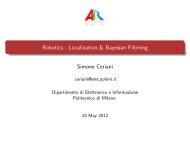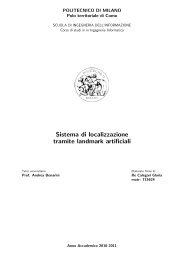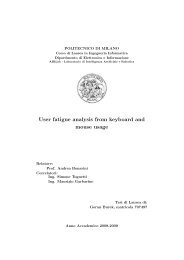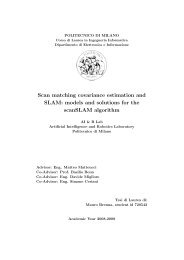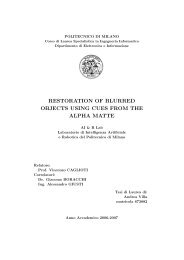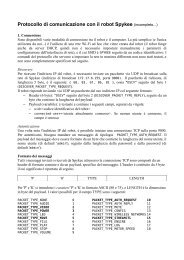Submitted version of the thesis - Airlab, the Artificial Intelligence ...
Submitted version of the thesis - Airlab, the Artificial Intelligence ...
Submitted version of the thesis - Airlab, the Artificial Intelligence ...
You also want an ePaper? Increase the reach of your titles
YUMPU automatically turns print PDFs into web optimized ePapers that Google loves.
58 Chapter 5. Vision<br />
The whole algorithm and script is found in Object’s Position section in<br />
Appendix B.2<br />
5.2 Color Definition<br />
The camera we are currently using has a UXGA resolution CMOS and it is<br />
set to 160x120 resolution for <strong>the</strong> blob search algorithm. One major problem<br />
is <strong>the</strong> blob search algorithm. The algorithm used inside is unknown and<br />
this forced us to define color information very precisely, since we cannot<br />
eliminate <strong>the</strong> non-object blobs easily. We can eliminate <strong>the</strong> problem only<br />
by using <strong>the</strong> area, perimeter and <strong>the</strong> circularity information which, in case<br />
<strong>the</strong> target is a ball, is not enough for most cases to track <strong>the</strong> blob. So this<br />
makes <strong>the</strong> color definition important. The color is defined in a RGB Cube,<br />
using RGB444 format, and it is not very clear to understand <strong>the</strong> correctness<br />
<strong>of</strong> <strong>the</strong> defined color from <strong>the</strong> color codes. In order to ease this process, <strong>the</strong><br />
color selection is made by <strong>the</strong>ST s<strong>of</strong>tware by selecting <strong>the</strong> desired color from<br />
<strong>the</strong> image, or directly programming <strong>the</strong> rules if <strong>the</strong> color values are known.<br />
Since <strong>the</strong> resolution is very low, <strong>the</strong> color consists <strong>of</strong> shadows, or existence<br />
<strong>of</strong> blob not belonging to <strong>the</strong> searched object made us to improve <strong>the</strong> color<br />
selection. The current ST s<strong>of</strong>tware is sufficient to visualize <strong>the</strong> selected color<br />
and test <strong>the</strong> blob search, but color definition is difficult since, in order to<br />
define <strong>the</strong> color, <strong>the</strong> pixels should be selected one by one, is not possible<br />
to select an area. Moreover, <strong>the</strong> rules (which is <strong>the</strong> additions and subtractions<br />
<strong>of</strong> <strong>the</strong> color codes to RGB Cube) found by <strong>the</strong> ST s<strong>of</strong>tware are not<br />
in <strong>the</strong> compact form (<strong>the</strong> same rule for a color can be added or subtracted<br />
more than one). To improve <strong>the</strong> color selection, we decided to use an <strong>of</strong>flinecalculator,<br />
that calculates <strong>the</strong>histogram for <strong>the</strong> selected object’s colors.<br />
As a first step, we started by disabling automatic white balance and automatic<br />
exposurecontrol. Before getting into <strong>the</strong> white balance, <strong>the</strong> concept<br />
<strong>of</strong> color temperature needs to be introduced. Color temperature is just a<br />
way <strong>of</strong> quantifying <strong>the</strong> color <strong>of</strong> light. It is measured in degrees Kelvin (K).<br />
Normal daylight has a color temperature <strong>of</strong> around 6,500K. Warmer light<br />
has a lower color temperature. The warm light that occurs late in <strong>the</strong> afternoon<br />
might have a color temperature <strong>of</strong> around 4,000K. Cooler light has a<br />
higher color temperature. Thebluish light that sometimes occurs in twilight<br />
periods <strong>of</strong> <strong>the</strong> day might have a color temperature <strong>of</strong> about 7,500K. So, our<br />
concept <strong>of</strong> warm and cool light is tied directly to <strong>the</strong> color temperature. The




